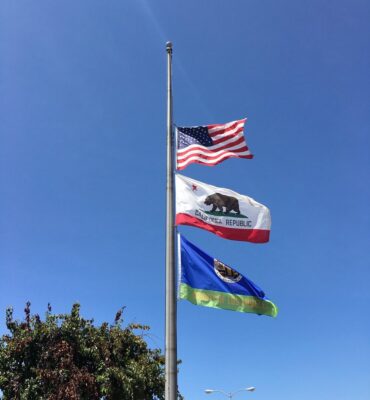The New York Metropolitan Museum of Art ranks among the world’s greatest. Sprawling across three locations with over 2 million art pieces, it’s the fourth-most-visited museum on the planet. Days — weeks, even — could be spent there, soaking in the sweep of human history told through brushstrokes, bronze and brilliance.
Carrie and I had just half a day. Let me say this: For $22 a head with the senior discount, the Met is the best enlightenment deal in America. If you find yourself in New York City, put it on your bucket list. If you give it time and attention, it might just change the way you see the world.
One exhibit in particular hit me like a lightning bolt. Zeroing in on the massive 1600s-1800s European and American exhibit, we didn’t have enough time — but more than enough to feel the punch.
We were walking through rooms showcasing the rise and fall of great European empires. Britain, naturally, featured heavily. The map of British expansion at its peak is staggering — how a small island came to dominate so much of the world is beyond belief.
Every section of the Met comes with a plaque offering historical and cultural context. Near the entrance to the 1600s gallery — a room dense with paintings, sculpture, household relics, and weapons — I read a panel that stopped me cold.
Here’s what it said, describing Britain’s global ascent:
“This is the story of a rising economy fueled by global trade and the expansion of the British Empire, a time when innovation and industry yielded both financial rewards and national confidence …
“Trade stimulates wealth, extends the cultural and economic elite beyond the aristocracy, broadens tastes, and introduces new markets for resourceful British makers. The arrival of skilled international artisans inspires invention with forms and materials to meet diverse consumer demands. New techniques and technologies change labor practices and encourage updated designs … Local pride accompanied global ambition — imperatives that continue to inform the modern political, creative and economic landscape.”
Those lines jumped out like sirens: “Trade stimulates wealth … broadens tastes … introduces new markets …”
“New techniques and technologies change labor practices and encourage updated designs.”
And it hit me — this is exactly what the “Make America Great Again” movement is ignoring. Instead of expanding outward through partnership, innovation and trade, we’re retreating inward and backward – slapping on tariffs, alienating allies, and trying to rewind the clock to a Norman Rockwellian time that no longer fits the world we live in.
Britain didn’t achieve global dominance by isolating itself or making everything at home. It rose through trade, through connection, through global exchange of ideas, goods and people. That’s what built the empire — and that’s what built the United States, too.
Trade isn’t weakness. It’s leverage.
Yes, America must maintain strategic independence. Yes, we need to protect key industries. But there’s a difference between smart protection and blind nostalgia. Trying to rebuild the American economy around 1950s-style industrial production — ignoring robotics, artificial intelligence, biotech, aerospace, globalized supply chains — isn’t just naive. It’s a dangerously self-destructive, nation-collapsing mistake.
America still leads the world in advanced education, programming, AI, aerospace, and other frontier technologies. Agriculture and energy remain high-value exports and vital local assets. Rather than slavishly “making everything ourselves,” we should lead globally as the international leader we are — into the future, not backward through one man’s sentimental journey.
And in trying to recreate a Norman Rockwell America of gritty factory men and children toiling away, we’re also imposing a tremendous tariff and inefficiency tax on the working and middle class. Soaring prices, fewer choices, and — soon — empty shelves, all thanks to tariff walls blocking our access to efficient production.
We could lose 10 years of advancement building billion-dollar factories making basic goods while other countries already make them for a fraction of the cost. Meanwhile, our middle class foots the bill through tariff-driven exorbitant prices and shrinking options.
It’s a self-imposed tax driven by a single man with a melancholy fever dream. A tax not passed by Congress but levied by irrational sentimentality.
I’m nearly 70 and remember the “good old days,” too. Two pairs of jeans cuffed 4 inches high, so you could grow into them for years – with enough patches. Canned vegetables instead of fresh. Forget food diversity. No A/C in the hot San Fernando Valley. And one car maybe, not three, in your family’s driveway.
Britain learned the hard way what tariffs and taxation without representation led to. So did we, in the Great Depression, and so will we soon enough again. Great nations come and go. But it’s trade—real, fair, strategic trade — that keeps the lights on in our modern world. When we turn inward, we don’t just lose access to goods — we lose access to ideas, to inspiration, to shared progress. That international edge America’s spent generations building? It dulls fast when we’re manually sawing wood in a post-dated fantasy factory.
Let’s not impoverish our people trying to reconstruct a sentimental version of a past that never really existed the way we choose to remember it. Let’s look forward. Let’s trade forward. Let’s lead forward.
At almost 70, I’ve lived through a lot — and for most of us, truth is, we’ve never had it better than now. I’ll take forward momentum over backward nostalgia any day.
That $22 senior ticket to the Met didn’t just open doors to history — it reminded us all how vital it is that we keep choosing progress over illusion.
Gary Horton’s “Full Speed to Port!” has appeared in The Signal since 2006. The opinions expressed in his column do not necessarily reflect the opinions of The Signal or its editorial board.











